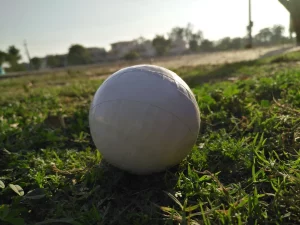- Tournament Rules Summary
- This is a 2-days Tournament with one extra-reserve day.
- A player who has played in one team is not allowed to play/switch into another team.
- All group matches would be of 6 overs (per inning).
- Final will consist of 8 overs (per inning).
- Forfeit time is ten (10) minutes after the scheduled game start time. If any one team is not “Ready to Play” within ten (10) minutes after the scheduled game start time, then that team will forfeit and the opposing team will be declared the winner (assuming the opposing team is “Ready to Play”).
- A match will consist of two (2) teams with eight (8) players, including a team captain. A match may not start if either team consists of fewer than five (5) players.
- Fibre Bats are ALLOWED.
- A good quality Tennis ball covered with WHITE ELECTRICAL TAPE (TAPE TENNIS BALL) will be used for all competitions.

- It is required that each team provide one (1) player (players can always rotate) to sit near or sit with the scorer so he / she can write correct names and do stats correctly for each player.
- UMPIRE’S DECISION WILL BE FULL & FINAL DURING ALL MATCHES. There is ZERO TOLERANCE for arguing with an umpire. If an explanation is needed, players must inform their respective team captains, and only team captain(s) may request further information from the standing Umpire.
- Any prolonged argument by a team, would yield a walkover to the opposition team based on the decision by umpires and organizers.
- If any team walks out of the ground on protest during the playtime, that team will be disqualified from the entirety tournament.
- For every win, a team would get 2 points and losing team won’t get any points. In case of a tie in the group stages, each team would get 1 point each. During knockout stage, if a tie happens, Super Over would be held.
- The participating teams may be asked to perform umpiring and scoring duties by the organizers.
- Proof of COVID-19 Vaccination is NOT mandatory in Quebec anymore.
- Innings/Match Duration:
- All matches (Except Final) – Each innings must be completed in 30 minutes and Innings break is 5 minutes. Total match duration is sixty-five (65) Minutes.
- The Umpires
- Umpire Positioning
- There will be two (2) umpires for each match.
- The bowler’s end umpire will stand behind the stumps on the end from which the bowler is bowling with a direct line of sight down the pitch facing the batsmen.
- A second umpire, the square leg umpire, will stand perpendicular to the batsmen on the leg side square to the batsmen. Umpire Decisions.
- THERE IS NO THIRD UMPIRE, therefore there will be no appeals from players or other persons of any on-field decisions made by the umpires.
- The ruling of the two on-field umpires is final on all decisions.
- The umpires have the right to discuss a decision before making a final ruling.
- The main umpire must initiate a request to discuss a ruling with the leg umpire.
- After the discussion, the umpires have the right to overturn the initial decision or keep the initial decision.
- These decisions include, but are not limited to, caught decisions, clean catches, bump balls, boundary decisions, batsmen running to the same end, wide balls and no balls.
- Fitness of ground, weather and light
- If conditions during a rain stoppage improve and the rain is reduced to a drizzle, the umpires must consider if they would have suspended play in the first place under similar conditions. If both on-field umpires agree that the current drizzle would not have caused a stoppage, then play shall resume immediately.
- The umpire may suspend play if the light is unfit/fit for play.
- Umpire Positioning
- The Innings
- Each inning shall be limited to a maximum of six (6) overs, each over consisting of six (6) legal balls/deliveries.
- One bowler can bowl a maximum of two (2) overs.
- In the event of a bowler breaking down and being unable to complete an over, the remaining balls will be allowed by another bowler. Such part of an over will count as a full over only in so far as each bowler’s limit is concerned.
- The bowler may not deliver the ball underarm. If a bowler bowls a ball underarm the umpire shall call and signal no ball.
- There are no Leg Before Wicket (LBW) dismissals in Tapeball Cricket.
- Batsmen are allowed to run on byes and leg-byes to score runs at their own discretion. Batsmen can be run out if trying to score runs on byes or leg-byes.
- Wide and No-Balls will be penalized by an extra delivery (an extra run counts along with WITH FREE HITS).
- No-Balls and/or Wide Balls resulting from inconsistencies in the pitch will be judged as occurred and no special considerations will be given due to the pitch.
- A ball bowled on the leg side of the wicket (beating batsman is a Wide Ball.
- No-Ball is one run plus the run(s) scored by batsmen on that ball.
- Any ball bowled directly over the waist height is a No-Ball.
- A ball bowled full step (over step) is a No-ball. Line belongs to umpire, therefore bowler must ensure some part of their foot is behind line/crease.
- Throw Ball (Batta / Watta / Tund) bowling is prohibited/Not Allowed.
- A batsman can be run out / stump out on a No-Ball / Wide Ball.
- Mankad Rule : A bowler can self-out the runner only after giving one (1) warning per match per team. The bowler has to inform the umpire and the umpire at his/her own discretion will warn the runner/team.
- When a batsman/runner is self-out (after the warning was issued), a ball will not be counted and is considered a “Dead Ball”.
- A dead ball is at the discretion of the umpire.
- If a ball is bounced out of the pitch area, it is considered “Dead Ball” and bowler must rebowl it.
- FREE HITS are awarded if bowler bowls a No-Ball.
- Umpires are instructed to apply very strict and consistent interpretation in order to prevent negative bowling wide of the wicket.
- A penalty of one run for a wide shall be scored.
- As a penalty, the ball must be re-bowled.
- Rules for super over
- The team batting second in the match will bat first in the Super Over.
- Batsmen from each team can bat and 1 bowler from each team will bowl.
- The entire fielding unit is allowed to field
- In case super over is tied, the below rules are applicable.
- Highest Number of 6’s (main + super over)– 1st priority
- Highest Number of 4’s (main + super over) – 2nd priority
- Least Number of wickets fallen (main + super over) – 3rd Priority
News Feed
- Vip escort Eskişehir
- Kuşadası orospu numaraları
- SSCC Tapeball Tournament on 19,20,21 August 2022
- Yatırımsız Deneme Bonusu Veren Siteler: En Güncel Hoşgeldin Bonuslarını Kullanarak Kazanın
- Deneme Bonusu Veren Slot Siteleri: Mega Jackpot Slotlarında Bedava Bonuslarla Kazanç Sağlayın
